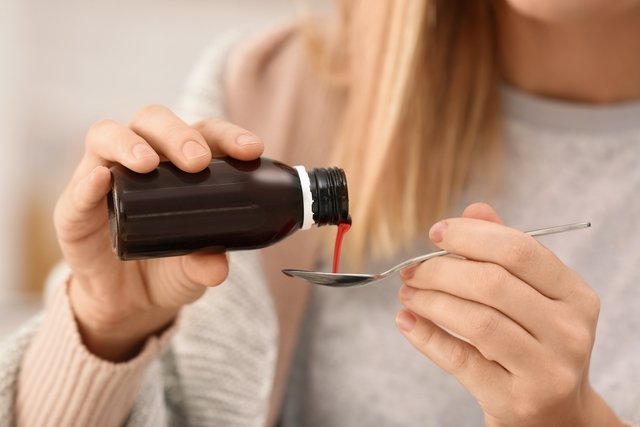Bronchitis syrups, such as acetylcysteine, ambroxol or acebrophylline, help relieve coughing with phlegm, as they have an expectorant and mucolytic action, which fluidizes the phlegm, leaving it more liquid, facilitating its elimination.
In addition to these syrups, in cases of acute bronchitis or exacerbations of chronic bronchitis, the doctor may also recommend the use of antibiotic syrups, such as amoxicillin or clarithromycin, for example.
Syrups for bronchitis should be used with medical advice, and therefore, you should consult a pulmonologist or pediatrician who can recommend the best syrup on an individual basis.

12 syrups for bronchitis
The pharmacy syrups most recommended by pulmonologists for the treatment of bronchitis include:
1. Acetylcysteine
Acetylcysteine is a mucolytic syrup that acts by fluidifying the secretions produced in the lungs, facilitating their elimination from the airways, and is indicated to help relieve coughs with phlegm.
This syrup can be indicated for acute or chronic bronchitis, and is available in the form of a 40 mg/mL adult syrup or a 20 mg/mL pediatric syrup that can be used by children over 2 years of age, with guidance from a pediatrician.
How to use: the dose of 40 mg/mL syrup for adults is normally 600 mg per day, which corresponds to 15 mL of syrup, once a day, preferably at night. See acetylcysteine doses for children.
Make an appointment with the nearest pulmonologist, who can recommend the best syrup for bronchitis, individually:
Taking care of your health has never been easier!
2. Ambroxol
Ambroxol syrup is an expectorant that can be used to treat bronchitis, especially chronic bronchitis, as it helps to make phlegm less thick, which makes it easier to eliminate. See all the symptoms of bronchitis.
In addition, they can also have an antitussive action that also helps to relieve coughing with phlegm, being found as a generic or under the names Mucossolvan, Sedavan, Bronxol or Ambroxmel, for example.
Ambroxol syrup can be found in different concentrations, being 6 mg/mL for adults and 3 mg/mL for children.
How to use: the recommended dose of adult ambroxol syrup of 6 mg/mL (or 30 mg/5mL) is 5 mL of syrup, 3 times a day. For children over 2 years of age, pediatric syrup must be used and doses must be advised by the pediatrician. Find out how to give ambroxol syrup to children.
3. Dextrometorfano
Dextromethorphan syrup is an antitussive and expectorant indicated to calm and relieve coughs, as it helps to reduce coughing by acting directly on the brain in the region that controls the cough reflex, relieving this symptom.
This syrup is normally indicated for colds and flu, however, it can also be indicated for bronchitis, especially chronic bronchitis, and should not be used when a bacterial respiratory infection is suspected.
Dextromethorphan syrup is found associated with guaifenesin under the name Vick 44E and can be used by adults or children over 6 years of age.
How to use: The recommended dose for adults and children over 12 years of age and weighing more than 43 kg is 15 mL of syrup, every 4 to 6 hours, up to a maximum of 6 doses per day. Learn how to take Vick 44 E syrup correctly.
4. Salbutamol
Salbutamol syrup is a bronchodilator that works by relaxing the muscle in the walls of the bronchi, opening the airways and allowing relief from chest tightness and coughing, making breathing easier. Understand what bronchodilators are and how to use them.
Salbutamol syrup 0.4 mg/mL is indicated for chronic bronchitis and is available as a generic or under the trade name Aerolin, suitable for adults or children over 2 years of age.
How to use: the normally recommended dose for adults is 10 mL of syrup (4 mg of salbutamol), 3 to 4 times a day, according to medical advice. For children, doses must be indicated by the pediatrician according to their age.
Another way to use salbutamol to relax the bronchial wall is in the form of puffs for inhalation or nebulization, especially in the elderly or people with reduced respiratory capacity. See other ways to use salbutamol.
5. Acebrofilin
Acebrophylline syrup is indicated for the treatment or prevention of diseases of the respiratory system, which cause bronchospasm and increased phlegm production, such as obstructive bronchitis or tracheobronchitis, for example.
This medicine has an expectorant and mucolytic action that helps relieve coughing with phlegm as it makes the phlegm more liquid and easier to eliminate, in addition to having a bronchodilator effect, making breathing easier. See other remedies recommended for coughing with phlegm.
Acebrophylline syrup can be found in two presentations of 50mg/5mL for adults and 25mg/5mL for children over 2 years old, as a generic or under the trade names Brondilat or Filinar.
How to use: the dose of 50 mg/5mL syrup for adults or children over 12 years of age is 10 mL (1 measuring cup) every 12 hours, or as directed by a doctor. See how to give pediatric acebrophylline syrup.
6. Carbocisteína
Carbocisteine syrup is indicated for chronic bronchitis, cystic fibrosis, pulmonary emphysema or other obstructive airway diseases, as it has a mucolytic action that helps make phlegm more liquid, facilitating its elimination.
This syrup can be found in its generic form or under the names Mucofan or Mucotoss, in concentrations of 50 mg/mL for adults and 20 mg/mL for children over 2 years old.
How to use: The dose of 50 mg/mL syrup for adults is 5 mL to 10 mL, 3 times a day, or as directed by your doctor. For children over 2 years old, the dose of 20 mg/mL children’s syrup is 0.25 mL per kg of body weight, 3 times a day, and should be used under the guidance of a pediatrician. Find out how to take carbocisteine correctly.
7. Bromexin
Bromhexine syrup is indicated for acute or chronic bronchitis, as it has an expectorant and secretolytic action, which helps to dissolve phlegm and activate the cilia of the bronchi, facilitating the movement of phlegm, allowing it to be eliminated more easily.
This syrup can be found in the form of 0.8 mg/mL pediatric syrup or 1.6 mg/mL adult syrup.
Bromhexine syrup must be used under medical advice and can be purchased as a generic or under the names Bisolvon or Pulmed, for example.
How to use: The normally recommended dose for adults or children over 12 years of age is 5 mL of 1.6 mg/mL adult syrup (or 8 mg/5 mL), 3 times a day, or as prescribed by a doctor. See also how to use children’s bromhexine syrup.
8. Levodropropizine
Levodropropizine syrup is indicated for bronchitis, laryngitis or tracheitis as it helps to relieve dry and irritating coughs, as it inhibits the cough reflex, relaxes the bronchial muscles and improves pulmonary ventilation.
Levodropropizine syrup can be found under the names Antux or Percof, containing 30 mg/5mL or 6 mg/mL of levodropropizine and can be used by adults or children over 2 years of age.
How to drink: the dose for adults or children over 12 years of age is 10 mL of syrup (1 measuring cup), up to 3 times a day, as per medical advice. For children between 2 and 12 years old, the dose should be calculated according to body weight. Find out how to take levodropropizine correctly.
9. Amoxicillin
Amoxicillin or amoxicillin + clavulanate is indicated in the case of respiratory infections, such as acute bronchitis, exacerbations of chronic bronchitis or bronchopneumonia.
This antibiotic may be recommended by the doctor for people who are not allergic to penicillins, as it is capable of eliminating bacteria from the respiratory tract.
How to use: the normal dose of amoxicillin syrup 250 mg/5mL for adults is 250 mg to 500 mg (5 mL to 10 mL) orally, 3 times a day, according to medical advice.
In the case of amoxicillin + clavulanate, the recommended doses for adults or children must be calculated by the doctor according to body weight. Find out how to take amoxicillin + clavulanate.
10. Clarithromycin
Clarithromycin is an antibiotic from the macrolide class, normally indicated as the first option for people allergic to penicillins, as it is capable of eliminating bacteria that cause infections in the upper and lower airways.
This syrup is normally indicated for exacerbations of chronic bronchitis and is available in the form of a 25 mg/mL pediatric syrup and a 50 mg/mL adult syrup.
How to use: the normally recommended dose for children aged 6 months to 12 years is 7.5 mg/kg of body weight of 25 mg/mL children’s syrup, every 12 hours, as directed by the doctor. See how to take clarithromycin correctly.
11. Axetilcefuroxima
Axetilcefuroxime is an antibiotic from the cephalosporin class, indicated in cases of acute exacerbations of chronic bronchitis, as it is capable of eliminating bacteria from the lower respiratory tract.
This syrup can be found in the form of a powder for oral suspension of 250 mg/5mL for adult or pediatric use in children aged 3 months and older.
How to use: the normally recommended dose for adults is 5 mL of syrup every 12 hours. For children from 3 months to 12 years of age, doses must be calculated by the pediatrician according to the child’s body weight.
12. Pelargonium sidoides
The syrup Pelargonium sidoides It is an herbal medicine indicated for respiratory tract infections, such as chronic or acute bronchitis, sinusitis, pharyngitis or rhinopharyngitis, for example, as it has antimicrobial action, in addition to modulating the immune system to fight infections.
This syrup can be found under the name Imunoflan, at a concentration of 307.39/mL and should not be used by pregnant women, nursing mothers, people with kidney or liver disease or by people being treated for alcoholism, as it contains alcohol in its composition.
Furthermore, diabetics should use it with caution, as the syrup contains sugar.
How to use: the normally recommended dose for adults is 7.5 mL of syrup, twice a day, as prescribed by a doctor. In addition to this herbal syrup, homemade syrups for bronchitis can also be used. See the main homemade syrups for bronchitis and how to prepare them.
Care when using syrups
Some syrups may contain sugar in their composition and should be used with caution by diabetics, and it is important to check with the pharmacist which brands do not contain sugar.
Furthermore, in some cases, it may be necessary to dilute the syrup, when it comes in the form of powder or granules, and check the amount of water that should be added, according to the manufacturer’s instructions.
It is also important to follow all medical recommendations for treating bronchitis, such as rest, increasing fluid intake or using a humidifier, to also help eliminate phlegm. See how bronchitis is treated.

Sign up for our newsletter and stay up to date with exclusive news
that can transform your routine!
Warning: Undefined array key "title" in /home/storelat/public_html/wp-content/plugins/link-whisper-premium/templates/frontend/related-posts.php on line 12
Warning: Undefined array key "title_tag" in /home/storelat/public_html/wp-content/plugins/link-whisper-premium/templates/frontend/related-posts.php on line 13



